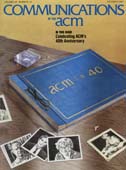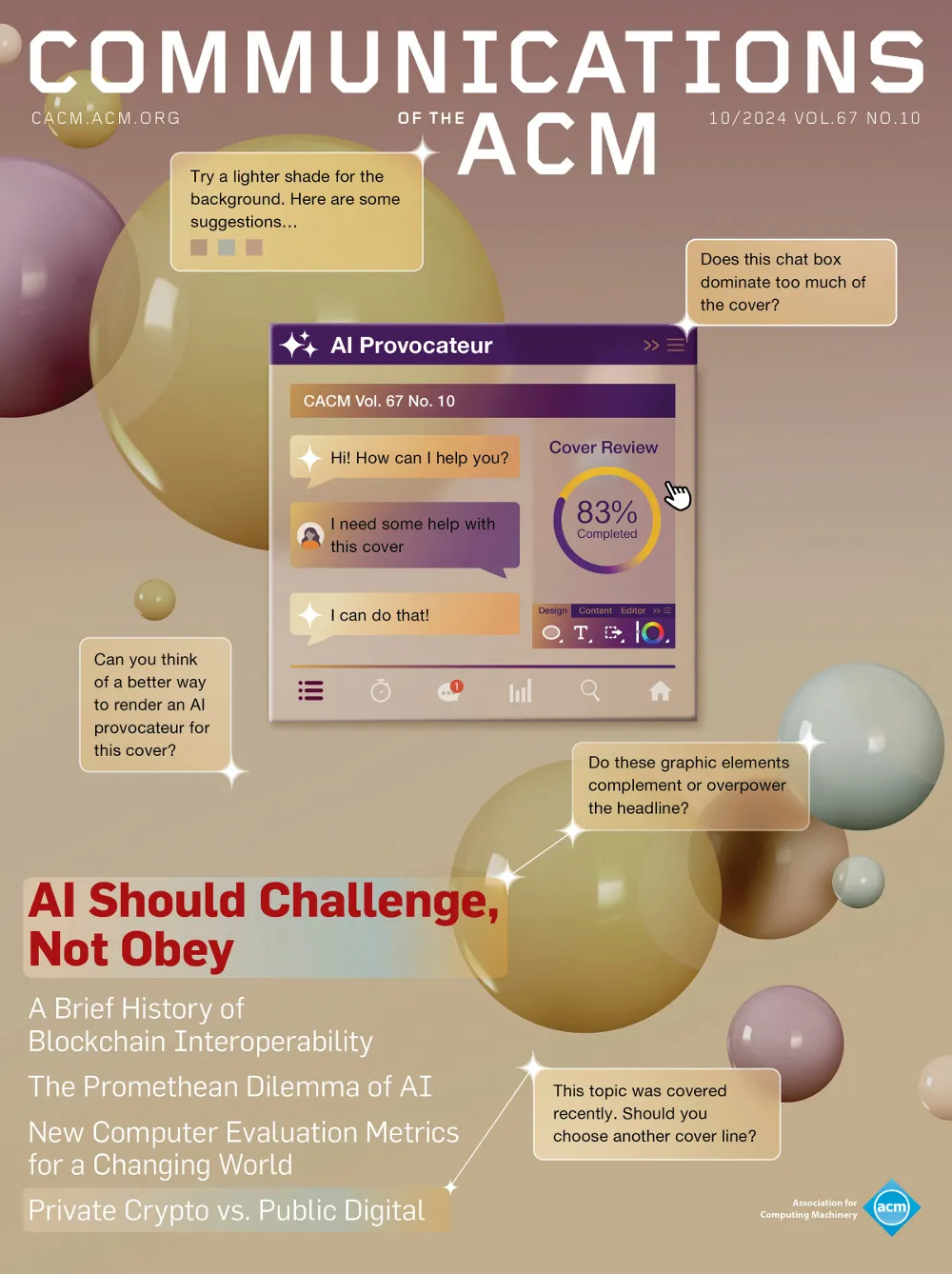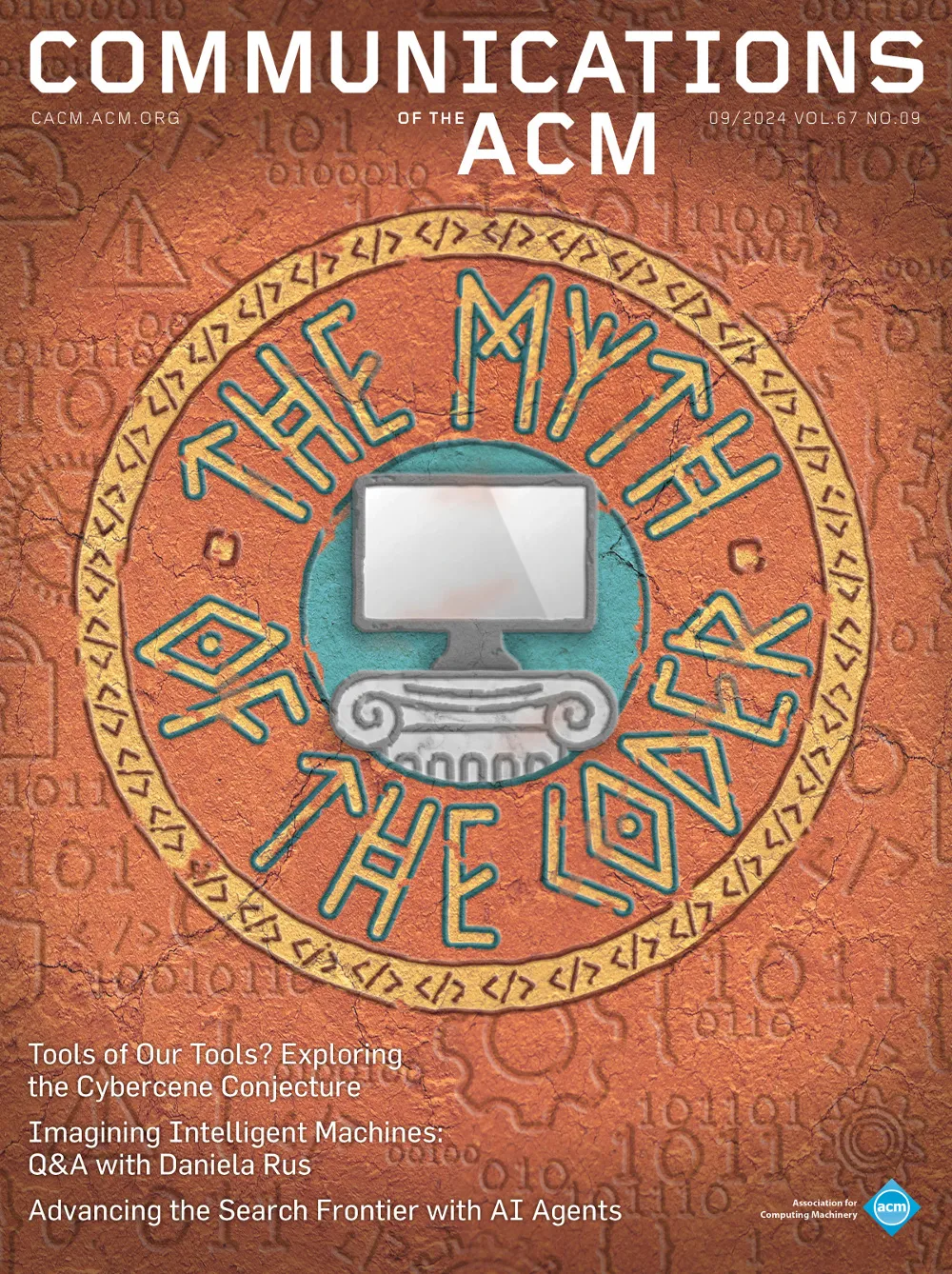October 1987 - Vol. 30 No. 10

Features
From Washington: public policy issues ripen with age
The computerists of 1947, as creative and foresighted as they were, could hardly have imagined that the industry they helped to mold would one day be forcing technological issues of worldwide consequence. Back then the idea was to figure out how to build computing systems; today the idea is to figure out how to live (peacefully) with what we've built.
As computing systems grew in popularity and use, so did the public's concerns over the impact these new machines would have on their lives and livelihoods. It would soon become the role of computing organizations like ACM to alleviate those fears by educating the public, and later the U.S. government, as to the true power and potential of its technological efforts. However, many computer people today contend that sharing information is not enough and are urging the scientific industry as a whole, and ACM in particular, to take a more active role in government and legislative activities. The technological issues at hand—SDI, trade sanctions, public security, international competition, among so many others—are too sophisticated, complex, and volatile to handle from the sidelines.
Political issues in the earliest days of the computing era most often involved business maneuvers. Edmund C. Berkeley, a founding member and first ACM secretary (1947-1953), remembers that, even in 1947, there was the hint of "corporate takeover" in the air as he wrote the original ACM bylaws with colleagues James Russell of Columbia University and E. G. Andrews of Bell Telephone. "The first bylaw we wrote stated that dues would be $2 per year," recalls Berkeley during a recent interview for Communications. "The second bylaw we wrote stated that ACM would never become an IBM organization. It was a possibility we all feared at that time because [IBM] was making use of 50 to 75 percent of the computer field. So we wrote up a rule to protect ourselves."
Public concerns over the social and political implications of this new technology did not surface until computers went commercial and data became public property, remembers Mina Rees, a member of the first ACM Executive Council in 1947. Before then, computer experts were too busy building systems to worry about their long-term effects. "We didn't have any of these bright youngsters around to tell us," she muses. "The [industry] people at that time didn't known about political or public concerns."
Rees's earliest memory of growing outside awareness of computerization backlash was in 1951 when the U.S. Census Bureau began automating its operation with Eckert-Mauchly's Univac (see p.832). "That was the first time people became aware that other people might be able to get hold of private information," she says. One way to allay those concerns was through education, and Rees was dedicated to spreading the word. "I made a point of accepting [speaking] invitations because, as an educator, I strongly believed the only way we would make progress would be to spread as much information as possible," she says. "There were deep sources of information and sharing that knowledge saved us from having to discover it a second time."
Profiles in computing: Donald E. Knuth: scholar with a passion for the particular
"Age 30 is kind of appropriate because I got the first copy of volume 1 from the publisher nine days after my 30th birthday. So, a large part of the work had been done when I was 30 years old. They already were working on typesetting the second volume."
Commenting on his books' influence, Knuth says, "It's been phenomenal from my point of view. In 1976 a study was done of how many people writing papers on computer science made a reference to my book somewhere in their articles, and it was found that about 30 percent of the papers in Communications, Journal of the ACM, and SIAM Journal on Computing cited the book. So it has an impact in that way." What about sales? Knuth notes that publishers may joke about professors whose books never sell, but they don't apply here. "I know that people buy the book. I don't know how many read it. But the sales have been incredible. I think something between 1000 and 2000 copies [have been sold] per month for 20 years."
Profiles in computing: Brian K. Reid: a graphics tale of a hacker tracker
"When the Securities Exchange Commission was created by Franklin Roosevelt, he was trying to fix a lot of problems on Wall Street. There were various Ivan Boesky-type crimes being committed on the stock market, and Roosevelt wanted to create a regulatory agency that would keep it in line. He wanted to hire a sheriff to police Wall Street. What he did was he hired the person who was absolutely, unarguably, the biggest criminal on Wall Street—the person who was guilty of the most crimes. And he put him in charge of the Securities Exchange Commission, figuring that that person, being the most successful Wall Street bandit, knew all the tricks and could police his friends. And that person did a really good job of cleaning up Wall Street actually, because he did know all the tricks."
"In a certain sense, I got my start in the computer business by bending the rules, or not knowing what the rules were. I was extremely good at penetrating everyone's computer security when I was a kid. And, because of my tremendous knowledge in this area, I have frequently been called in to help catch people who break in. . . ."
Profiles in computing: Allan L. Scherr
"Most of the work I've done has been done to break things into existence that didn't exist before. . . . In a sense, my whole career's been about building organizations that didn't exist before, creating processes to do things that have never been done before, and solving technical problems that hadn't been solved before. The work I did at MIT was that way as well. There was no real foundation to build on, and I had to make it up as I went along. That's characterized, if not my whole career, at least the parts of my career that I consider the most rewarding."
"Pioneers are also the people that get arrows shot through them. That's the downside, and I've had my share of arrows pulled out of my hide."
The computing program of the Office of Naval Research, 1946-1953
The Office of Naval Research (ONR) played a vital role in the postwar support of basic research in the sciences at the nation's universities in the years immediately following World War II before the establishment of the National Science Foundation in 1950 and its expanded funding a few years later. Part of ONR's mathematics program was devoted to the support of computers and computing, and this article will report on that aspect of ONR's activities and the related activities at the National Bureau of Standards (NBS).1
The establishment of ONR at the end of World War II reflected the concern of several of the naval officers who had been associated with the work of the wartime Office of Scientific Research and Development (OSRD) and of leaders in both the legislative and executive arms of the government that the vitality and momentum of wartime research would be lost in the postwar years and the level of civilian scientific research would be disastrously diminished. This concern was formulated by Secretary of the Navy James V. Forrestal in a memorandum he sent to the president, dated February 1945, in which he said, "The problem which began to emerge during the 1944 fiscal year is how to establish channels through which scientists can [contribute to the nation's security by carrying on research] in peace as successfully as they have during the war." In response to this initiative and the support it received, ONR was established by act of Congress in 1946. In June of that year, I was invited to go to Washington to set up its program in the mathematical sciences.
I had been executive assistant to Warren Weaver, the chief of the Applied Mathematics Panel (AMP) of OSRD during the war, and had frequent dealings with several of the naval officers attached to the U.S. navy's liaison office with us. It was one of these officers who suggested my name to Alan Waterman, the first chief scientist of ONR whom I had known in OSRD. Although I thought it somewhat unlikely that mathematicians would be enthusiastic about accepting support for their peacetime research from one of the military services, I decided, after talking with some of my wisest friends, to accept the appointment. During the early days of my tenure, I traveled widely around the United States to discuss with senior research mathematicians the type of program that would be desirable and appropriate, and their willingness to participate in it. The only guidelines laid down by the navy for the determination of this program were those set by Public Law 588 of 1946, which, in the words of the preamble, established
an Office of Naval Research in the Department of the Navy; to plan, foster, and encourage scientific research in recognition of its paramount importance as related to the maintenance of future naval power, and the preservation of national security; to provide within the Department of the Navy a single office, which, by contract and otherwise, shall be able to obtain, coordinate, and make available to all bureaus and activities of the Department of the Navy, world-wide scientific information and the necessary services for conducting specialized and imaginative research; to establish a Naval Research Advisory Committee consisting of persons pre-eminent in the field of science and research, to consult with and advise the Chief of such Office in matters pertaining to research.
The program we designed after wide consultation received the blessing of Captain Robert D. Conrad, USN, the military officer who was responsible for the entire contract research effort of ONR and was viewed by the staff as the spiritual father of ONR. In 1947 he wrote to me that I had "won the title of mathematical architect of O.N.R."
The program we planned provided for the support of research in pure and applied mathematics, statistics, and computer development with its related numerical analysis to ensure the sophisticated use of electronic computers when they became available. Implementation of this broad policy was in the hands of the staff, and an able staff was assembled. The objective was to develop a program of first-class mathematical research that was of long-range interest to the navy and to identify mathematical results of potential importance to the navy wherever and whenever they appeared (see [21]). One such result that appeared very soon was George Dantzig's work in linear programming, which, as I will report later, gave rise to a substantial and important logistics program in ONR.
The development years of ACM, as recounted in 1962 by founding member and former president Franz L. Alt, depicts the players and progress of an organization committed to sharing computing knowledge and skills.
Commentaries on the past 15 years
A longtime member comments on the trends, happenings, events, and accomplishments of ACM in the period 1972-1987, followed by "Self-Assessment Procedure XVII."



